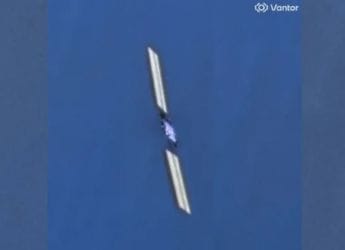- Home
- Science
- Science News
- NASA Uses New Technique to Find a Planet Which Orbits Around Two Different Stars
NASA Uses New Technique to Find a Planet Which Orbits Around Two Different Stars
Researchers used NASA’s Transiting Exoplanet Survey Satellite (TESS) to discover the planet.

Photo Credit: Dr. Pamela Gay/ Planetary Science Institute via SETI Institute
Circumbinary planets orbit around two different stars
NASA scientists have found evidence for a new transiting circumbinary planet. The term refers to any planet which orbits around two different stars. The evidence was received using an unprecedented technique. Researchers used NASA's Transiting Exoplanet Survey Satellite (TESS) to discover this unique planet. With the use of TESS and its predecessor Kepler space telescope scientists have discovered 14 such planetary bodies till now. Before this discovery, such planets existed only in the speculative and hypothetical realms of science and science-fiction literature.
A paper on the new discovery was published in the Astronomical Journal on November 10, 2021. According to it, the planet was detected from a single sector of TESS data.
Nader Haghighipour, a scientist at the Planetary Science Institute and an author on that paper, said that finding circumbinary planets was much more complicated than detecting planets orbiting around single stars. He added that at least three transit events were required to determine the orbit of a planet. The Independent quoted him as saying, “This becomes complicated when a planet orbits a double-star system because transits will not happen with the same interval over the same star.”
Studying the required three transits for a circumbinary planet also required more time as the orbits of these planets were a lot longer than those of their binary stars.
However, the TESS technique allowed scientists to speed up the process. According to a report on SETI Institute's website, the detection of this planet required 27 days, two transits, and three eclipses from a single sector of TESS data.
Haghighipour, who is also the founder of the TESS Circumbinary Planet Working Group, added, “Our group was able to show that despite its short window of observation, it is still possible to use TESS to detect circumbinary planets. The new planet is the proof of the validity, applicability, and success of our invented technique.”
Get your daily dose of tech news, reviews, and insights, in under 80 characters on Gadgets 360 Turbo. Connect with fellow tech lovers on our Forum. Follow us on X, Facebook, WhatsApp, Threads and Google News for instant updates. Catch all the action on our YouTube channel.
- Samsung Galaxy Unpacked 2025
- ChatGPT
- Redmi Note 14 Pro+
- iPhone 16
- Apple Vision Pro
- Oneplus 12
- OnePlus Nord CE 3 Lite 5G
- iPhone 13
- Xiaomi 14 Pro
- Oppo Find N3
- Tecno Spark Go (2023)
- Realme V30
- Best Phones Under 25000
- Samsung Galaxy S24 Series
- Cryptocurrency
- iQoo 12
- Samsung Galaxy S24 Ultra
- Giottus
- Samsung Galaxy Z Flip 5
- Apple 'Scary Fast'
- Housefull 5
- GoPro Hero 12 Black Review
- Invincible Season 2
- JioGlass
- HD Ready TV
- Laptop Under 50000
- Smartwatch Under 10000
- Latest Mobile Phones
- Compare Phones
- Huawei Nova 15
- Huawei Nova 15 Pro
- Huawei Nova 15 Ultra
- OnePlus 15R
- Realme Narzo 90x 5G
- Realme Narzo 90 5G
- Vivo S50 Pro Mini
- Vivo S50
- Asus ProArt P16
- MacBook Pro 14-inch (M5, 2025)
- Huawei MatePad 11.5 (2026)
- OnePlus Pad Go 2 (5G)
- Huawei Watch 10th Anniversary Edition
- OnePlus Watch Lite
- Acerpure Nitro Z Series 100-inch QLED TV
- Samsung 43 Inch LED Ultra HD (4K) Smart TV (UA43UE81AFULXL)
- Asus ROG Ally
- Nintendo Switch Lite
- Haier 1.6 Ton 5 Star Inverter Split AC (HSU19G-MZAID5BN-INV)
- Haier 1.6 Ton 5 Star Inverter Split AC (HSU19G-MZAIM5BN-INV)












